Introduction
Nasal bone fracture or broken nose is one of the commonest facial bones injuries. It is occurs when there is a break or crack of the nasal bone due to direct trauma to the nose. In most cases, there is also fracture of the nasal septum, the inner partition that divides the left and right sides of the nose.
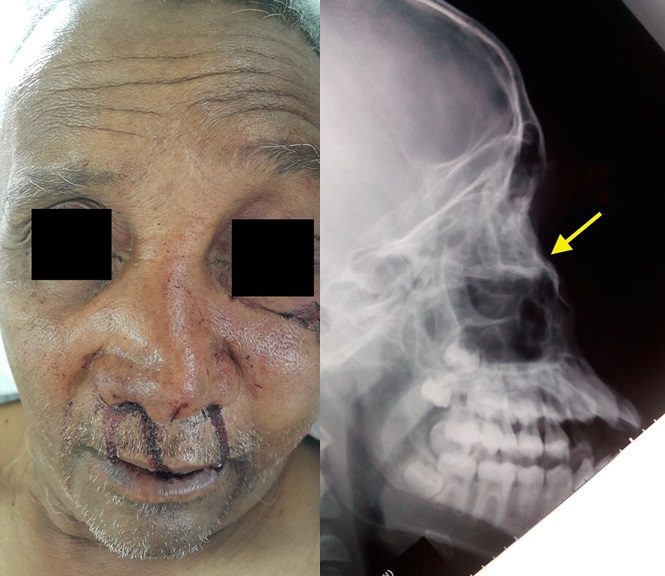 |
| Fig 1: Angulated nasal bone fracture and correspond x ray |
Type
Type of nasal bone fracture according to direction of impact:
- Depressed fractures
They are due to blows from the front. - Angulated fractures
They are due to blows from the side.
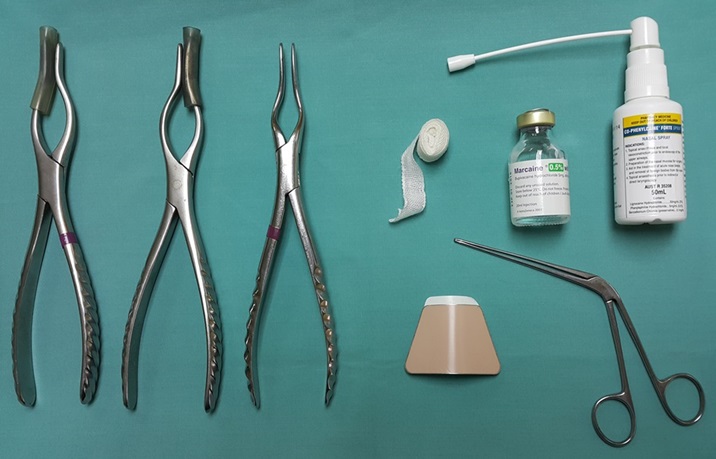 |
| Fig 2: Instruments used in closed nasal bone reduction |
Causes
The commonest cause of nasal bone fracture is facial trauma and may resulting from any of the following:
- Motor vehicle accident
- Contact sports (football, hockey, rugby, boxing, martial arts)
- Falls
- Assault
- Walking into a fixed object such as a door or wall
- Rough, wrestling-type play
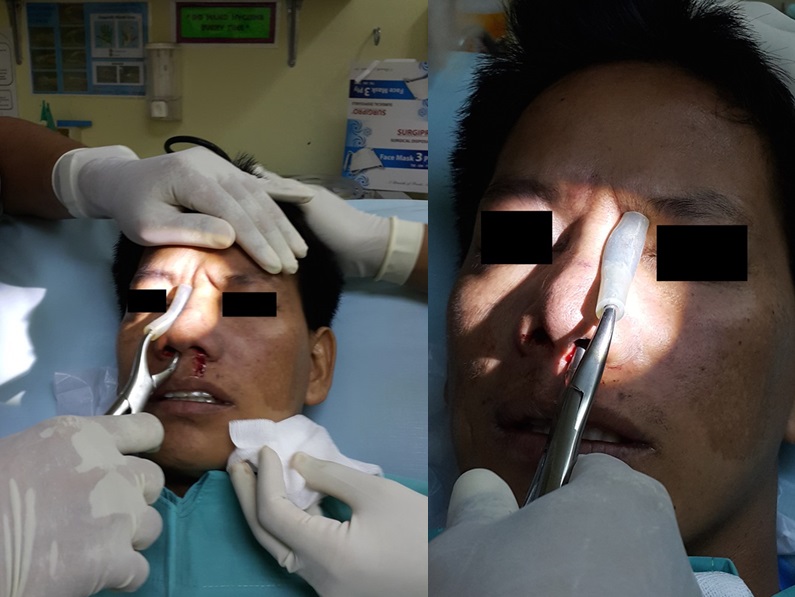 |
| Fig 3: Closed nasal bone reduction using LA in progress |
Signs & Symptoms
Signs and symptoms of nasal bone fracture are:
- Pain over the nose especially on touch
- Nose bleed or epistaxis (usually stopped by itself)
- Swelling of the nose and its surrounding areas
- Bruises around the nose
- Nasal blockage (can be one or both of nasal passages)
- Deformed or crooked nose
- Disturbance of sensation of smell
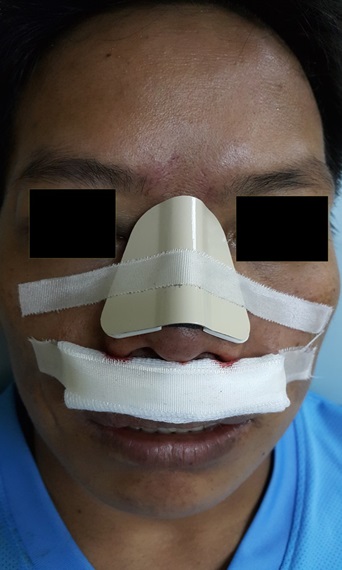 |
| Fig 4: Patient using external nasal splint after reduction |
Diagnosis
Most of the time, nasal bone fracture can be diagnosed clinically i.e. from the patient’s history and the clinical examination of the nose and its surrounding areas. Nasal bone x ray (lateral view) can be done as supporting evidence especially in medico-legal cases.
 |
| Fig 5: Depressed nasal bone fracture before and after reduction |
Complication
Complications or injuries related to a nasal bone fracture may include the following:
- Septal haematoma
A Collection of clotted blood in the nasal septum is due to the bony fracture. It will cause nasal blockage and may require emergency surgical drainage as it may leads to destruction (necrosis) of the septal cartilage. - Septal abscess
Untreated septal haematoma may lead to necrosis of the septal cartilage and may become become infected to form septal abscess. - Nasal bridge deviation or crooked nose
Fractured nasal bone will result in an ugly looking deviated or crooked nose, which is very prominent as the nose is located at the centre of the face. - Deviated nasal septum
Fractured nasal septum will cause deviation of the septum and subsequently narrowing of the nasal passage. - Recurrent epistaxis
Recurrent epistaxis can occurs due to dryness and crust formation of the deviated part of the septum. Peeling of the crust exposed the blood vessels which easily bleed. - Saddle nose
A Saddle nose is one where there is a depression just above the nasal tip as the nose loss it framework support. - Disorder of smell
The patient may experience disturbance of the smell, if the fracture involved the roof of the nose (olfactory cleft – where the ‘smell nerve’ is located).
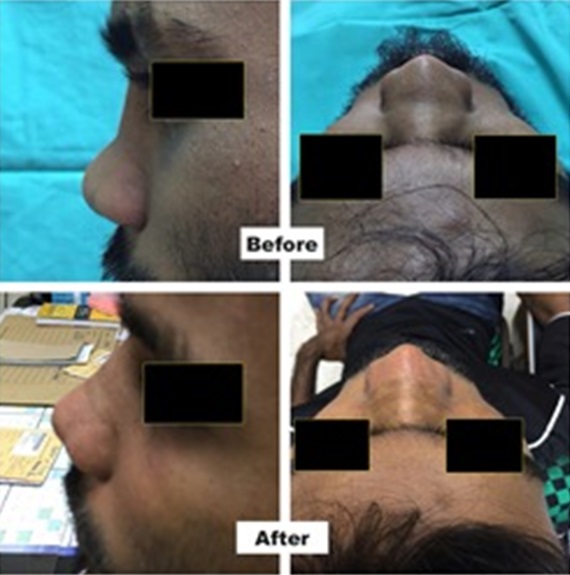 |
| Fig 6: Depressed nasal bone fracture before and after reduction |
Treatment
The treatment of nasal bone fracture depends on the symptom and the degree of displacement of the fractured bones.
Treatment to relief symptoms are:
- Ice pack – to reduce the swelling and stop epistaxis
- Pain killer – to relieve pain
- Decongestant nasal spray – to reduce the swelling and clears the nasal passages
No treatment is needed in the case of simple fractures without displacement.
If the fracture is severe with obvious deformity, the fractured nasal bone can be realign manually in a procedure called closed nasal bone reduction.
The presence of swelling may interferes with accurate reduction by closed method. Therefore, the best time to reduce it, is before the swelling appears or after it has subsided (usually in 5-7 days after the trauma).
This procedure is usually done in clinic setting using local anaesthesia (LA). The nasal passage is packed with decongestant agent with LA and the nerves around the nose are blocked with LA infiltration to ease the pain during the procedure. Walsham’s forceps are used to reposition the fractured bone and Ash’s forceps are used for fractured septum. The reduced fragments are immobilized with padded aluminium splint placed external for at least 2 weeks.
This procedure can also be done under general anaesthesia especially in young patient and those who cannot tolerate the pain.
However, it needs to be done within 14 days post trauma before callus formation (healing process of fractured bone) occurs. After this period, the realignment can be done surgically (open reduction) where in a procedure called a rhinoplasty or septorhinoplasty, which aims at reshaping the nose to improve its appearance.
References
- Diseases of Ear, Nose and Throat, 4th edition (2007), PL Dingra, Elsevier
- A Short Practice of Otorhinolaryngology, 3Rd edition (2007), KK Ramalingam, All India Publisher & Distributors
- Scott-Brown’s Otolaryngology, Rhinology 6th edition (1997), IS Mackay & TR Bull, Butterworth-Heinemann
| Last Reviewed | : | 13 August 2015 |
| Writer | : | Dr. Khairul Azhar b. M. Rajet |
| Accreditor | : | Dr. Faridah bt. Hassan |







